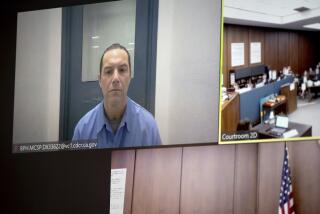New DNA Testing Provides Hope for Some Inmates : Science: Test can be used on blood or semen that is years old; it helped free a man who had been on Death Row. But some states set time limits for new evidence.
- Share via
BALTIMORE — A new genetic test that won freedom last week for a onetime Death-Row inmate has the potential to reopen thousands of criminal cases around the country.
But inmates fighting to overturn their convictions may find other roadblocks: destroyed evidence or state laws that set time limits on introducing new evidence.
Kirk Bloodsworth of Cambridge was freed last Monday from the Maryland House of Correction after testing showed his DNA didn’t match semen found on the underpants of a 9-year-old girl who was raped and murdered in 1984. Bloodsworth maintained his innocence through two trials and nearly nine years in prison, two spent on Death Row after his first conviction.
“There easily could be several thousand people across the country who are in prison and in fact innocent, and this could be proven through DNA testing,” said Peter Neufeld, chairman of the National Assn. of Criminal Defense Lawyers DNA task force.
Neufeld, a defense attorney in New York, based his estimate on DNA testing conducted by the FBI on sexual assault cases. In tests that yield conclusive results, roughly one-third exonerate the suspect, he said.
“If there are that many people who are being exonerated, then think of all the people who did not have the benefit of DNA testing and were tried and convicted,” Neufeld said.
DNA, or deoxyribonucleic acid, is a molecule in each nucleus of cells in the body. It forms an individual’s genetic makeup, sort of a genetic fingerprint. DNA from a crime suspect can be compared to DNA found in body fluids or tissue left at a crime scene.
The test that exonerated Bloodsworth looked for the gene that is the code for a protein found on white blood cells. The procedure is so new that the FBI has only been using it since April, 1992.
It requires only a small sample for results and can be used on old and degraded tissue, Neufeld said. It is the equivalent of molecular photocopying, where a tiny piece of DNA is replicated over and over until it is large enough to be analyzed, he said.
“It is an absolute result. When an individual has been excluded, he is found not to be a contributor of the blood or that semen,” said Dwight Adams, unit chief of DNA analysis for the FBI’s Washington laboratory.
But inmates convicted before the test was available who now want to be tested may find key evidence destroyed. Neufeld said there is no requirement that police officers or prosecutors maintain evidence after a conviction.
“That ended up to be the key to this case,” said Bloodsworth’s attorney, Robert Morin. “When we first got on this case four years ago, we filed a motion with the trial court to seal all the evidence. Had it not, it could have been thrown away.”
Forty-one states impose time restrictions for introducing new evidence after convictions. In Maryland, the limit is one year after the last appeal, although prosecutors agreed to waive that in Bloodsworth’s case.
In Virginia, attorneys for Walter Snyder Jr. got around the time restrictions in that state by petitioning Gov. Douglas Wilder, who granted an unconditional pardon in the case. Snyder had spent seven years in prison for rape, a crime he was cleared of through DNA testing.
But just as DNA evidence can be used to exonerate suspects, it also can be used to convict them.
“When this kind of information is difficult to defend, defense attorneys are screaming that juries shouldn’t hear it,” said Ed Blake, a scientist with Forensic Science Associates in Richmond, Calif.
More to Read
Sign up for Essential California
The most important California stories and recommendations in your inbox every morning.
You may occasionally receive promotional content from the Los Angeles Times.










